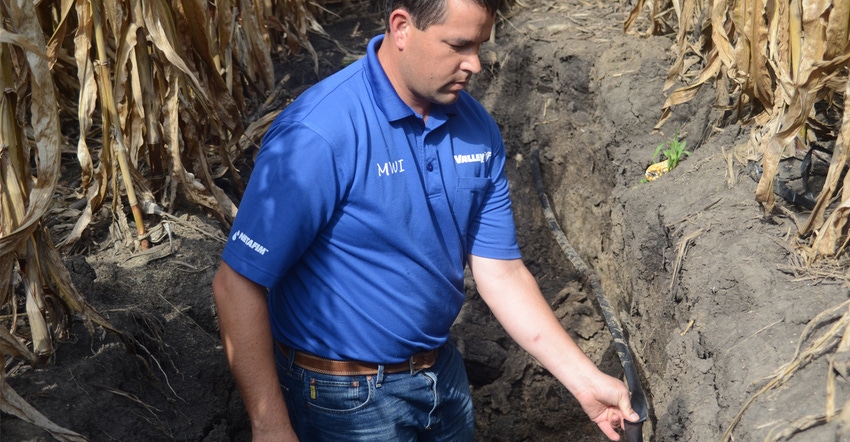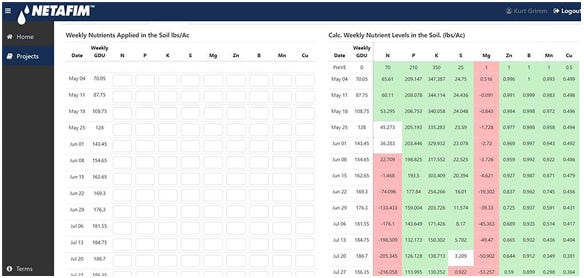
For Great Plains states such as Nebraska and Kansas, center pivots make up the bulk of irrigation systems. However, for irrigators with abnormally shaped fields, hilly fields, pivot corners or those who want high management and high yields, subsurface drip irrigation may be an attractive option.
However, SDI also offers a way to improve crop water use and nutrient uptake by delivering them closer to crop roots. But for those hoping to use their SDI system for fertigation, there are a few factors to consider, notes Kurt Grimm, chief operating officer of NutraDrip in Hiawatha, Kan.
Here are Grimm's recommendations:
1. The most important consideration is using the right fertilizer source and understanding water quality. "We have to look at the cleanliness of the fertilizer and know how it's going to react with water," Grimm says. "Water pH is extremely important. If growers have high-pH water or a lot of calcium in the water, there's a higher likelihood something like a phosphorus product is going to react when you inject fertilizer. In general, the No. 1 fertilizer you can't put in drip is polyphosphate — like 10-34-0, which is what many use for starter fertilizer. That will almost never work."
He recommends growers do a jar test — testing the compatibility of the product by putting the mixture in a clear jar and shaking it up. If the water stays clear, it's OK to use. If it turns milky or sediment settles out, the mixture may pose problems with clogging lines and emitters.
2. Understand the travel time for certain fertilizer sources in different drip systems. "You start injecting fertilizer, you have to understand it takes an hour to get from my fertilizer pump to the very end of my drip line — or whatever the travel time may be," Grimm says. "The rule of thumb is we always water an hour before we start fertigating and make sure we have an hour of fresh water before we're done fertigating to clean all fertilizer out of the lines, as well as ensuring we get a uniform distribution of fertilizer across the field."

BLUEPRINT: Netafim's fertility tool can be used as a kind of blueprint to understand how much of a certain nutrient crops need at different growth stages, Kurt Grimm says.

3. The amount of water used in fertigation also should be taken into consideration, depending on the product being applied. "You have to think about where your roots are at, and make sure you put out enough water to move fertilizer far enough," Grimm says. "For example, with phosphorus, when you water with drip, it comes out of the emitter and makes a wetted area. The size of the wetted area changes based on how much moisture is in the soil and how long you water.
"When you inject phosphorus, it will only move to the outer extent of that wetted circle the first time it's applied. If you put out a quarter-inch of water and it goes out 6 inches from the emitter, phosphorus will only go out 6 inches."
On the other hand, nitrogen is applied more often, and in higher amounts — and it's much more mobile in the soil. So, it's usually a bigger concern to apply too much water.
4. Measure the electrical conductivity of water, which measures dissolved salts. This last point builds on the previous two. Understanding how fast a solution moves through the system can be measured by using an EC meter — collecting a sample at the flush valve on the far end of the field every five or 10 minutes, and seeing how fast the system gets fertilizer and water to the far end of the field by measuring EC. The EC level in source water rises (typically from 1 to about 2 or 2.5 deciSiemens per meter, depending on the concentration) when fertilizer is added.
For growers who have multisensor profile probes with EC, understanding the movement of nutrients in the soil is even more important. "If you've applied a lot of fertilizer in the top 12 inches and get a 5-inch rain, you look at the various EC sensors and see that your salt content moved down — there's a large rise in EC at the 3-foot level, and EC dropped at the 12-inch level — you know the fertilizer dropped below the roots and is not available anymore," Grimm says.
As noted earlier, fertigating through SDI involves different timing compared to fertigating with a center pivot. Grimm, a Netafim dealer, notes Netafim's fertility tool also can help create a prescription for fertigation with drip based on yield goal, soil sample data and preapplied nutrients.
"Then we plug in the planting date and day length of the hybrid and the tool will chart out, based on all those parameters, how many pounds of N, P and K are needed every week," he says. "We apply nutrients through drip to match that uptake. Understanding the timing of the nutrients with the growth patterns of the plant is really where we're picking up efficiency."
About the Author(s)
You May Also Like






